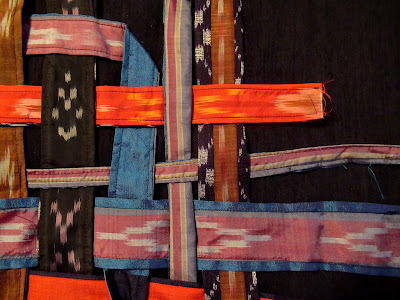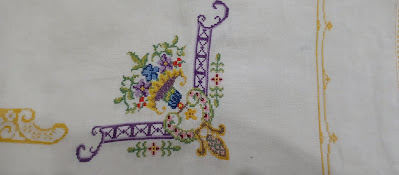Right now I am working on several projects at once. While visually they are not at all similar each one is about connecting the user to the past.
I grew up in a house that my parents moved into during the summer of 1957. My mother moved out about a year after my father died. People who are better at numbers than I am at numbers say that was fifty-five years in the same house. My friend Frank grew up quite differently. He was born in Burma. Frank's father was an academic and got on the wrong side of the government so Frank went to kindergarten in Rangoon. I no longer remember all of the places Frank and his brother lived during their young lives but clearly, they saw a whole lot more of the world than I did living in Quincy.
Frank's parents sucked up the culture wherever they lived. Frank's mom bought fabrics and had clothes made for her bought shoes ( I was lucky enough to briefly own a pair of her brass-heeled embellished high-heeled mules which I passed on to the girl who lives across the hall from us.) Frank's parents also bought art, sculpture, and artifacts.
Frank, his wife Esther and his brother took care of their parents as they descended into paranoid dementia. Caring for aging parents is always hard. This was extra hard. Franks's parents died within a week of one another. Several months ago Frank and Esther came to me with a box filled with silk blouses that Frank's mom had made for her in the late 1950s and early 1960s out of fabulous Ikat dyed silk in Burma, a couple of other silk blouses made elsewhere in Asia and a couple of lengths of silk.
I was tasked with making two wall hangings, one for Frank and the other for his brother.
I carefully unpicked each of the blouses and then cut each blouse into the stripes created by the Ikat dye patterns. I backed each of those stripes with more of Frank's mother's silk and made a bunch of tubes.
I have been weaving those fabric tubes together.
I rarely do work that is quite this abstract. It has been slow going because I need to keep adjusting the compositions and reevaluating my work. I haven't done work quite this abstract since college. Frankly, it is both a little terrifying and also quite satisfying.
Several years ago I was asked to turn Grandpa Isiah's tallit into kippot to be worn at his namesake's bar mitzvah. Grandpa Isiah died days before baby Isaiah's brit-milah.
I was so touched working with this family.
The tallit on the face of it was just a tallit, not especially fancy. But the love that the family had for him has turned every bit of the tallit into a treasure. The family kept every bit of the tallit that didn't go into the kippot.
Now Grandpa Isiah's granddaughter, Isiah's little sister is having her bat-mitzvah. I am incorporating the remnants of the tallit into her tallit.
The corner pieces and the atara from Grandpa's tallit will become part of the new tallit. The base of the tallit will be an ivory silk tussah. I am creating stripes with ribbons chosen by the bat-mitzvah girl.
I have been layering and embroidering the ribbons.
I am so touched by the way this family has turned the ordinary into treasures by the force of their love. In the next few days, I will begin assembling this tallit.
Earlier in Covid-land, I began having outdoor dinners at our local diner with Terry a synagogue friend. Terry is more than ten years older than I am and was caring for her mother who was over one hundred years old. At one dinner Terry quipped that she thought that her mother was probably immortal. A couple of weeks later, she died.
Losing a parent, even when that parent is over one hundred can be hard. My mother recalled being surprised when my grandfather's mother died in 1938 and my grandfather was fifty years old. My grandfather sighed and said in Yiddish "Now I am an orphan!" Of course, it sounds more poignant in Yiddish. My mother recalled being puzzled by her father's outburst then but as she became an adult she understood his sentiment.
Terry wanted me to make her a tallit out of a tablecloth her mother had embroidered for her. Terry's mother was a skilled needlewoman.
What you see here is the back of the tablecloth. Terry's mother embroidered cloth for each of her daughters as they turned twenty.
If I were a better blogger I would have taken a before photo of the cloth.
The cloth was embroidered with an oval wreath of roses and foliage all done in taupe cross stitch. It took a bit of staring at the cloth to figure out which bit of the embroidery to use in the main chunk of the "stripes". I chose the two curved oval ends for that.
Here you see the two curved bits cut to size and edged with serging. Terry came up with the brilliant idea of making the base of the tallit black. It will make her mother's embroidery pop.
Terry spoke about how this tallit will help her feel wrapped up in her mother's love.
If you had asked me twenty years ago if I would spend any time at all mending old tablecloths I would have replied that that would be about as likely as my tap-dancing naked across the Brooklyn Bridge. Well, I don't tap dance either clothed or naked and certainly not across the Brooklyn Bridge. But lovely old tablecloths keep coming into my life.
I hand wash them I iron them and yes, I even mend them.
I am very fond of this sweet cloth. I suspect that it was made around WWI. The pattern may have come from a women's magazine or it may have been purchased as a kit as part of the "artistic needlework" craze of that era. The embroidery is really well done.
There were a few holes just above the yellow cartouche.
I starched and ironed the linen and then began stitching a network of weaving from the back of the cloth. Owning cloths mended by other women has made me braver about attempting this work and more forgiving of the imperfection of my mends. You see my work below.
There may have been women who owned this cloth who would have sniffed at the quality of my mending. There are probably others who would declare it good enough. My work is visible when you have your nose up to the piece and is less visible from a normal viewing distance.
This cloth will continue showing up in the center of our Shabbat table in rotation with the handwork of other women.
I am grateful to have clients who understand the power of textiles to connect us to the past.















Mending is something of a lost art - unless you are the thrifty Momma of little boys who like to play on their knees like my grandsons.
ReplyDeleteLast year, as I was reviewing treasures in one of my cedar chests, another daughter spied a hand pieced cover that always protected the cedar chest in my parents bedroom from my Dad's keys & climbing kids. (It was made by my Dad's mother before she passed away in 1957 for her sister-in-law, then passed with the cedar chest to us a few years later.)
My daughter exclaimed that the colors exactly matched her dining room walls. After a close examination, I figured out a way to mend the frayed bits and restore it - at least well enough to mount on her wall. I hadn't done a blanket stitch in many years, so like your mending, I would have to declare my efforts "good enough." But my daughter loves it, and I smile when ever I see it in her home.
Today I will be diving into the tablecloths at the bottom of the cedar chest - looking for a particular linen one to shibori dye for a new project.
My mother felt ashamed of the torn and worn. As I have inherited more old linens that have been mended by many hands over the decades I have become fonder of adding my own work to the conversation taking place on the fabric.
ReplyDelete